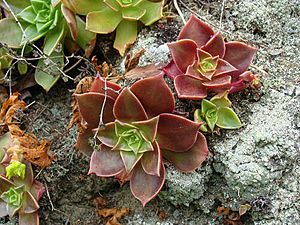Laguna Beach liveforever facts for kids
Quick facts for kids Laguna Beach liveforever |
|
|---|---|
 |
|
| Conservation status | |
| Scientific classification | |
| Genus: |
Dudleya
|
| Species: |
stolonifera
|
The Dudleya stolonifera is a type of succulent plant often called the Laguna Beach liveforever. This plant is very rare and only grows in one specific place: along the coast of Orange County, California. When a plant or animal only lives in one small area, it is called endemic.
There are only about six groups of these plants near Laguna Beach, with around 30,000 plants in total. Because it is so rare, the United States government has listed it as a threatened species. This means it is protected by law to help it survive.
What it Looks Like
This Dudleya plant grows from a main stem that does not branch out. This main stem is called a caudex. What makes this plant special is that it also grows stolons. Stolons are like horizontal stems that grow along the ground or just under it. New plants can sprout from these stolons, which is how the plant spreads itself.
The Laguna Beach liveforever has a small group of pointed, reddish-green leaves that form a shape like a rose, called a rosette. It also grows a short stem that has a cluster of bright yellow flowers at the top. This cluster of flowers is known as an inflorescence.
Where it Lives
The Dudleya stolonifera likes to grow on very steep, rocky cliffs made of sandstone. These cliffs are often found in areas with coastal sage scrub or chaparral habitats. The cliffs can be so steep that they are almost straight up and down, or even hang over!
This plant grows in very thin soil where not many other plants can survive. You will often find the dudleya growing among mosses and lichens. Sometimes, you might also see the California polypody fern nearby. Scientists think that a certain type of lichen, Niebla ceruchoides, might help the dudleya. It could act like a soft bed for the dudleya's seeds when they fall to the ground.
Plant Hybrids
Sometimes, the Laguna Beach liveforever can mix with other types of Dudleya plants. When two different species create offspring together, it is called hybridizing. This plant sometimes hybridizes with Dudleya edulis in places where both plants grow. It also sometimes hybridizes with Dudleya lanceolata.
Protecting the Plant
This rare plant faces several challenges that threaten its survival. Even though its habitat is very rugged and hard to build on, nearby city growth can still harm the plant. This is called the edge effect, where changes from nearby development can affect the plant's environment.
In the past, people would collect these plants from the wild after they were listed as threatened. However, this is not a big problem anymore because the places where they grow are too difficult for most people to reach. Also, animals like livestock used to eat or step on the plants, which was harmful. But now, grazing has stopped in the area, and the plants are recovering.
Today, climate change is a concern for the Dudleya stolonifera. Because there are only a few small groups of these plants, a big local event like a wildfire could wipe them out. Also, problems like inbreeding depression can make the plants weaker over time if the populations are too small.
Another threat comes from other plants, especially non-native ones. These are plants that were brought to the area by people and do not naturally belong there. They can compete with the dudleya for space and resources. For example, in one area, an invasive plant called Aeonium haworthii is taking over the dudleya's space.
Images for kids
-
In addition to hybridizing with Dudleya edulis, this species also hybridizes with Dudleya lanceolata. Pictured is the flower of a hybrid.







